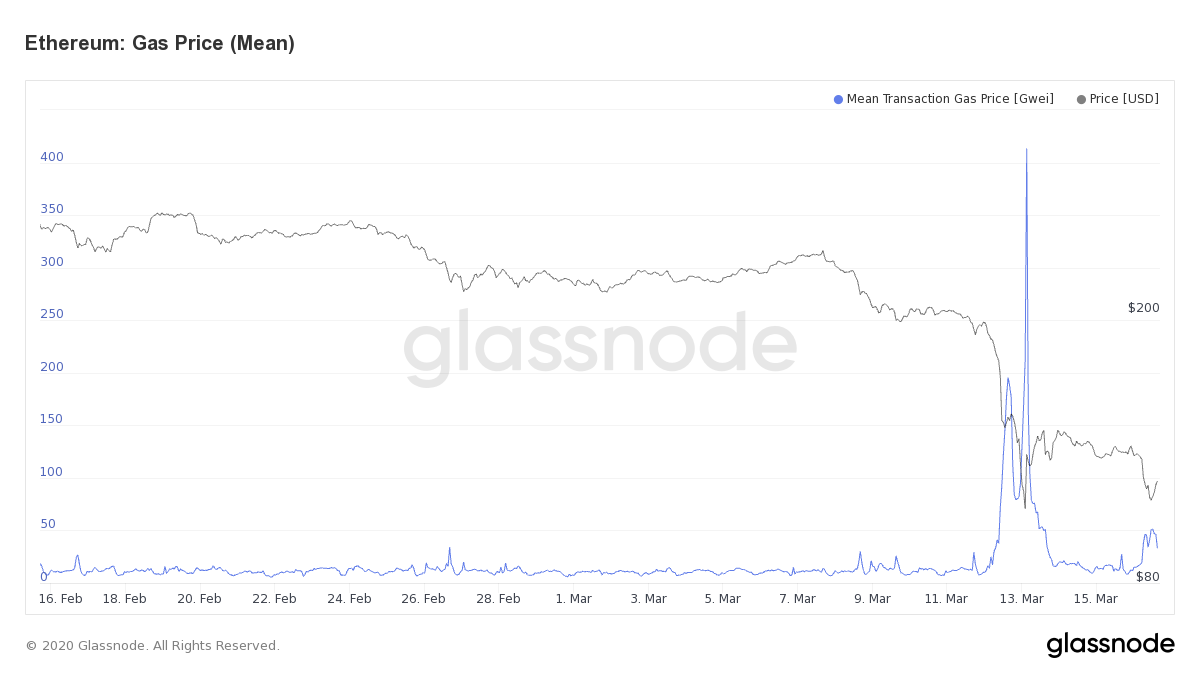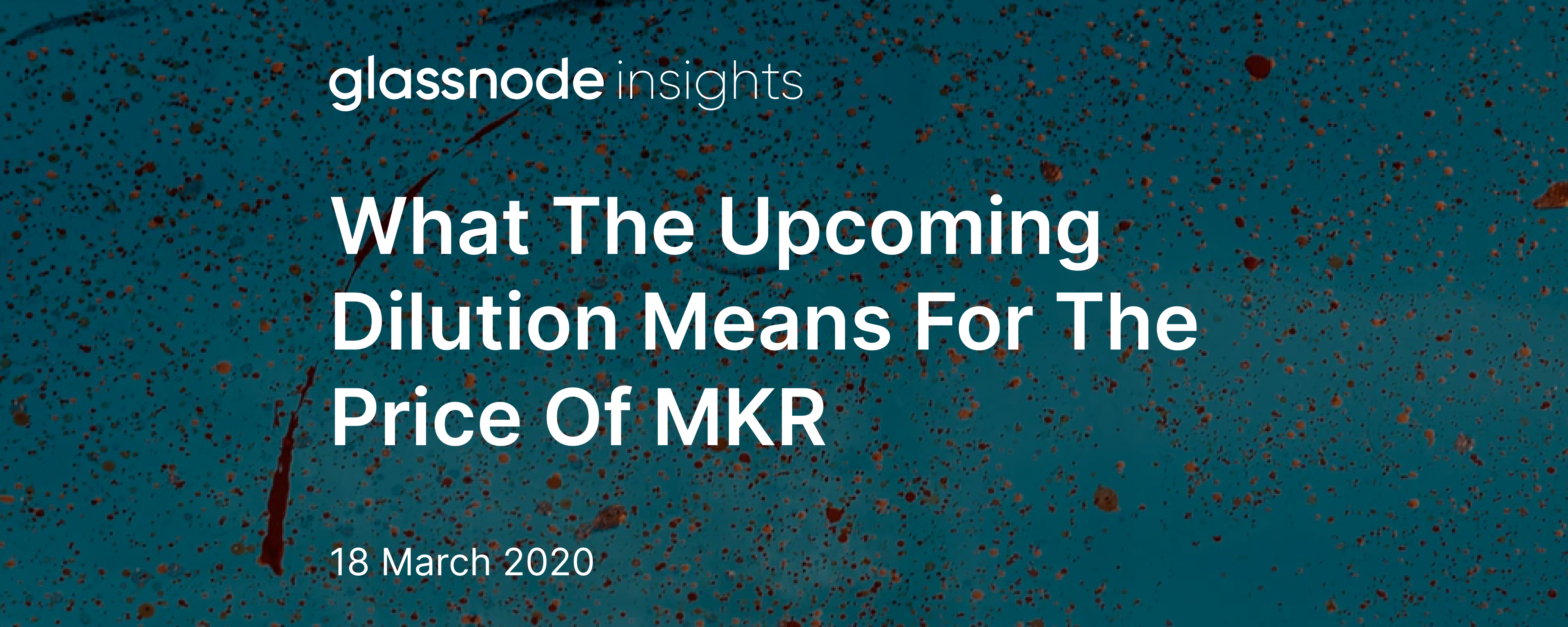What Really Happened To MakerDAO?
Black Thursday: The sell-off of 12 March resulted in $4.5 million of unbacked DAI in the MakerDAO system. What really happened?

The massive crypto sell-off on 12 March saw the price of ETH fall 43% from $194 to $111 - its largest ever loss in a single day.
This sell-off triggered unintended consequences for the MakerDAO ecosystem. Dubbed "Black Thursday", this sent the Maker system into chaos as $4.5 million worth of DAI was left unbacked by any collateral, and users lost millions.
News outlets and industry commentators have been reporting on these events, but a clear account is hard to come by. Many market observers have been left asking: what really happened to MakerDAO?
TL;DR
- Ethereum Network Overwhelmed, Gas Prices Increased - On 12 March, the Ethereum network was overwhelmed by demand as the price rapidly plummeted. The transaction queue grew as network capacity was reached, and gas prices shot up by an order of magnitude.
- Price Oracles Failed - Due to uncharacteristically high gas prices, price oracles including the Maker 'Medianizer' failed to update their feeds.
- CDP Liquidations Lagged, Then Were Triggered En Masse - When the Medianizer feed was updated, the reported price instantly decreased by over 20%, causing many CDPs to be liquidated immediately.
- ETH Was Sold For Free Through Maker - Again due to high gas fees and network congestion, when the ETH collateral in these CDPs was auctioned off, many bids did not get through. This allowed some liquidators to win these auctions with bids of zero DAI by paying high gas fees, extracting over $8 million worth of ETH essentially for free.
- CDP Owners Left With Millions In Losses - This exploit means that over $4.5 million of DAI in the MakerDAO system is now unbacked. In addition, users whose CDPs were liquidated (and whose ETH was sold to the zero-bid liquidator) lost 100% of their collateral, resulting in millions of dollars of losses for the DeFi community.
1 - The Ethereum Network Was Overwhelmed As The Price Fell
As the price of cryptoassets across the market began to plummet early on March 12, on-chain volumes spiked massively, and ETH deposits to exchanges hiked as users scrambled to react to falling prices across the market.

At the same time, many Ethereum dapps saw their highest ever daily activity. This, combined with increasing deposits to exchanges, overwhelmed the network.
The mean gas price for the day spiked over 6x to almost 80 Gwei, with mean hourly prices reaching almost 200 Gwei (according to Glassnode’s hourly data).

2 - ETH Price Oracles Failed
The increase in on-chain activity was especially significant for DeFi apps, which were overwhelmed by the radical spike in demand.
One of the most notable consequences was caused by the failure of pricing oracles offered by projects such as MakerDAO and Chainlink. With gas prices so high and so many transactions in the queue, these oracles were unable to update their price feeds quickly enough to keep up with the rapidly decreasing price of ETH.
Chainlink’s ETH price feed stalled for hours as it waited for price updates to make their way through the queue of transactions. The Maker ‘Medianizer’ oracle also provided radically incorrect ETH price data, giving a price of $166 when the real price was around $130.
3 - CDP Liquidations Lagged, Then Were Triggered En Masse
Positively, this gave some network participants time to top up or pay off their Maker CDPs, which would otherwise have been liquidated. By paying high gas fees, they were able to rescue their CDPs before the Maker price oracle was updated on-chain.
However, it also meant that when the price provided by the oracle was finally updated, many CDPs were suddenly liquidated en masse.

CDP automation systems such as DeFi Saver were unable to rescue many users’ CDPs, as the price instantly dropped from above their configured minimums to below a 150% collateralization ratio. These users therefore had their CDPs liquidated despite having put safeguards in place, as their safeguards relied on accurate and regularly updated price data.
Further, some CDPs whose liquidations hadn't completed (i.e. their collateral had not yet been purchased) were nonetheless liquidated even after the ETH price went back up, because price oracles were again too slow to reflect this change.
4 - ETH Was Sold For Free Through Maker
The tumbling ETH prices and slow oracles on 12 March led to a massive amount of Maker CDP liquidations, but high gas fees on Ethereum led to an even more dire situation for the MakerDAO ecosystem.
Refresher - How CDP liquidations work: When Maker CDPs (“vaults”) are liquidated, the collateral they contain gets auctioned off by the Maker system to pay back the CDP owner’s debt and the 13% liquidation penalty. Entities who purchase this collateral (“Keepers”) can make bids for bundles of 50 ETH, with auctions open for a limited amount of time, and ETH collateral selling for slightly less than market value.
The purpose of these auctions is to raise enough DAI to pay back the CDP debt. However, because gas prices on Ethereum on 12 March were so high and the queue was so long, bids which offered “regular” gas prices weren’t being processed fast enough.
Taking advantage of this network delay, a liquidator (likely a bot) was able to win these auctions with bids of zero DAI, essentially buying bundles of 50 ETH for free (aside from the comparatively nominal gas fee they paid to front-run the auctions). Several copycat liquidators also joined in on this exploit after noticing these strange auctions.
Auctions with zero bids successfully winning on @MakerDAO.https://t.co/e4ji2gVWe8 pic.twitter.com/m0CjoZVAAn
— Vishesh 🔬 (@visavishesh) March 12, 2020
Over $8 million in ETH was liquidated for zero DAI by these few opportunists exploiting vulnerabilities in the MakerDAO auction system.
This resulted in a net loss for the MakerDAO system, as the auctions did not raise the amount of DAI required to pay back the attached CDP debt. Because of this anomaly, at least $4.5 million (at the time) worth of DAI was left unbacked by any collateral.
5 - CDP Owners Left With Millions In Losses
Not only did this exploit leave the Maker system undercollateralized, but the users whose CDPs were liquidated lost all of the additional collateral in their CDPs.
Because CDPs are overcollateralized by default, these users should have received the total ETH value of their CDP minus their debt and the 13% liquidation penalty. However, because their ETH collateral was sold for zero DAI, they were left with nothing.
Users took to Reddit to ask questions:


As u/BitBurst noted, many MakerDAO users lost their life savings. The largest liquidated CDP lost around 35,000 ETH, equivalent to ~$4 million USD at current prices. Community members are calling for MakerDAO to rectify the situation.
The Aftermath
Patching the System
Shortly after the exploit occurred, MakerDAO conducted a vote on how to prevent this from happening again. New system parameters have increased the maximum lot size from 50 to 500 ETH and increased the duration of auctions. Further solutions such as minimum bid amounts on auctions are also being explored.
Re-Collateralization of DAI
The Maker community vetoed an Emergency Shutdown in favor of less drastic measures. Instead, as per the Maker whitepaper, the main way in which the system will be re-collateralized is via the printing and auctioning of new MKR tokens:
If the Collateral Auction does not raise enough Dai to cover the Vault’s outstanding obligation, the deficit is converted into Protocol debt. Protocol debt is covered by the Dai in the Maker Buffer. If there is not enough Dai in the Buffer, the Protocol triggers a Debt Auction. During a Debt Auction, MKR is minted by the system (increasing the amount of MKR in circulation), and then sold to bidders for Dai.
This sale mechanism will dilute existing MKR holders, considered fair "punishment" for their failure to maintain steady backing for DAI via good protocol governance.
The community is also proposing a reduction of the DSR (Dai Savings Rate) and the Global Stability Fee, in order to bring the DAI price closer to its 1 USD peg.
Redress for Liquidated CDP Owners?
At this time, it is unclear whether further MKR tokens will be minted and sold in order to cover the losses suffered by CDP owners who were liquidated. Many community members are calling for this as an "act of good faith", stating that it will also help the protocol's reputation in the long run.

Other community members have pointed out the irony of Maker's response to the event, stating that it "sounds a lot like the traditional system DeFi was supposed to disrupt."

The system of "the richest few (MKR holders) must apply and adjust monetary policy to decide the fate of the many (DAI users)" does seem eerily similar to the way financial systems work in the traditional world, and users of the MakerDAO ecosystem are concerned for its future.
What Does This Mean For MKR?
To find out what this series of events means for the price of the MKR token, read our follow-up analysis:

Subscribe to Glassnode Insights below for updates.

- Follow us and reach out on Twitter
- For on–chain metrics and activity graphs, visit Glassnode Studio
- For automated alerts on core on–chain metrics and activity on exchanges, visit our Glassnode Alerts Twitter
Disclaimer: This report does not provide any investment advice. All data is provided for information purposes only. No investment decision shall be based on the information provided here and you are solely responsible for your own investment decisions.

